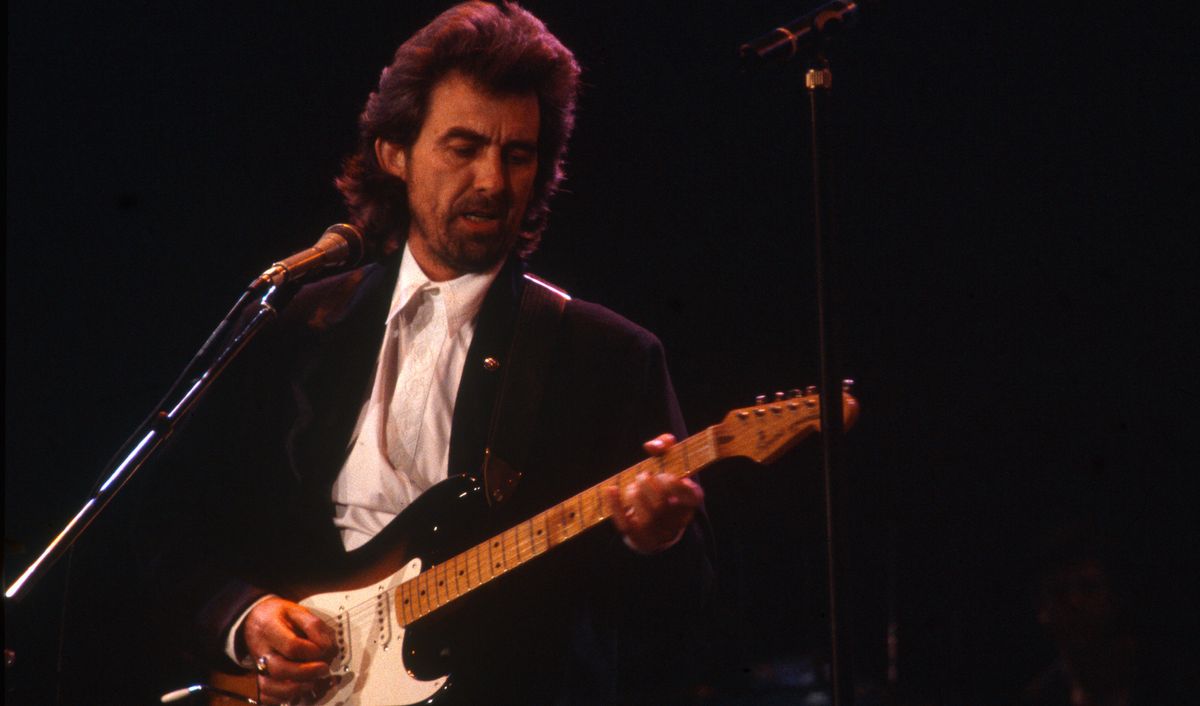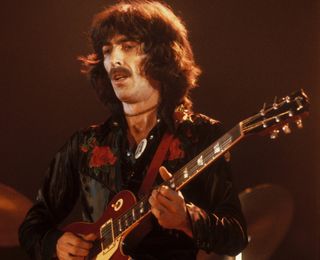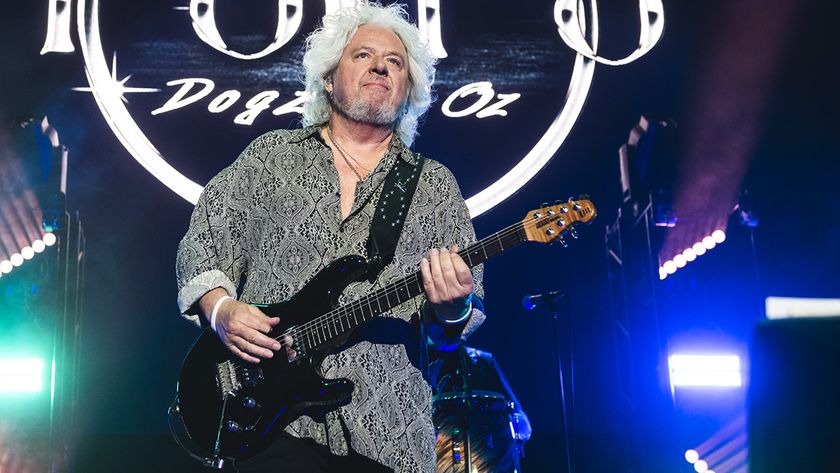George Harrison's 15 greatest guitar moments after The Beatles
Following the breakup of the Beatles, Harrison invented an entirely new, distinctive, and often-imitated guitar persona for himself. Revisit the finest of those post-Beatles six-string moments

Authors, journalists and bloggers of all shapes and sizes have dedicated millions of words to the merits and behind-the-scenes details of legendary albums such as the Rolling Stones’ Exile on Main St. But how many books have you read about Mick Jagger’s 1985 solo debut, She’s the Boss? How about Bill Wyman’s 1974 album, Monkey Grip? Should we even bother asking about Charlie Watts’ Long Ago & Far Away?
Let’s face it, regardless of how great they might be, albums by individual members of iconic bands – from the Stones to the Beatles to Led Zeppelin to the Who – rarely, if ever, attain the same mythic status as the music released by the bands themselves.
For instance, let’s take this George Harrison fellow.
Guitar magazines (like this one) have slathered decades’ worth of praise on Harrison’s 1962-to-1970 guitar work with the Beatles. We’ve taught you how to play his Something solo and applauded his introduction of sitars and 12-string electric guitars to pop music. We’ve even dedicated a lesson or two to his late-Beatles-era acoustic work.

But what about his music and guitar playing after the Beatles?
The late Harrison started playing slide in the late Sixties while touring Europe with Delaney & Bonnie, suddenly inventing an entirely new guitar persona for himself. What he came up with was a unique, distinctive and often-imitated style that incorporated hints of Indian music and a few quirky things he picked up while learning sitar – all of which he tossed into the mix with other Beatles-esque odds and ends.
He debuted his new sound on his first proper solo album, 1970’s All Things Must Pass, and refined it over the years on his subsequent albums and as a highly sought-after session player, if you can call a former Beatle a session player.
Get The Pick Newsletter
All the latest guitar news, interviews, lessons, reviews, deals and more, direct to your inbox!
Here, we revisit 15 of the finest examples of Harrison’s studio guitar work recorded after the Beatles’ breakup in April 1970.
My Sweet Lord – George Harrison (All Things Must Pass, 1970)
All Things Must Pass caused a sonic boom when it was released in late 1970. Harrison, a junior songwriting partner to John Lennon and Paul McCartney for way too long, emerged from his bandmates’ colossal shadows with a masterpiece.
The album, considered one of the greatest releases in 'solo Beatles' history, is packed with songs the guitarist had been stashing away since 1966, including a few that didn’t make it onto Beatles albums.
Treasures abound at every turn, including My Sweet Lord, the album’s lead-off single. And while its gorgeous twin-slide motif and majestic, gripping solo might not be the most technically challenging things Harrison ever recorded, they boldly announced the arrival of 'George Harrison: slide guitarist.'
They also helped draw a set of blueprints that’ve been used by other artists, including America (Sister Golden Hair), Todd Rundgren (I Saw the Light), Eric Carmen (All by Myself) and Teenage Fanclub (The Cabbage).
During the solo (at 2:47), Harrison’s intonation and muting tidiness (very important when playing slide in standard tuning) are impeccable. Reprising his intro lick a whole step higher, now in F# and with a brighter, bridge-pickup tone, Harrison outlines his chord progression with a bold, slippery melody based on major, minor and diminished-seven arpeggios, the latter harmonized in thirds below the melody via an overdubbed second lead guitar.
Gimme Some Truth – John Lennon, Imagine (1971)
Lennon’s successful Imagine album marks one of the only times he recorded with Harrison after the breakup of the Fab Four (the pair also backed Ringo Starr on I’m the Greatest in 1973).
Harrison’s playing can be heard on several Imagine tracks, including Oh My Love, I Don’t Wanna Be a Soldier and How Do You Sleep? He even plays a mean resonator on Crippled Inside. But there’s just something downright chilling about his slide work on Gimme Some Truth, a song the Beatles toyed with briefly during the Let It Be sessions.
Harrison wasn’t a shredder by any means; the magic resides in his note choices, structure, phrasing and emotional delivery – a trait he shared with David Gilmour and, to a lesser extent, B.B. King.
In this angry-sounding solo, which starts at :49, he uses his slide to achieve a piercing, sustained, singing tone with plenty of bite. Harrison makes good use of an open tuning for his slide melodies – and the stacked major triads that it affords at any given fret – as he plays a lyrical melody that outlines the chord tones, swooping into them from below and letting notes at the same fret ring together on adjacent strings. And then there’s that vibrato!
Back Off Boogaloo – Ringo Starr, Single (1972)
Harrison’s slide guitar is all over this Richard Starkey composition, the follow-up to Ringo’s first hit single, 1971’s It Don’t Come Easy, which also features shimmering guitar work by Harrison.
The song, which Harrison produced, features Starr on drums and vocals, Beatle buddy Klaus Voormann on bass guitar and Gary Wright on keyboards. But the main event is clearly Harrison’s slightly wild, wacky and bouncy slide work, which includes an alternate melody line that’s even catchier than the melody Ringo is singing.
Harrison played several tasteful solos on Ringo’s songs throughout the decades, including Early 1970, You and Me (Babe), I’m the Greatest, Down and Out, Wrack My Brain, You Belong to Me and King of Broken Hearts.
Give Me Love (Give Me Peace on Earth) – George Harrison, Living in the Material World (1973)
Everything came together for Harrison on this track, the first single from Living in the Material World.
First there’s the quality of the song’s message and melody, both of which stick with you long after the final notes fade away. But more importantly (as far as we’re concerned), there’s Harrison’s mid-song solo (at 1:51), which – with its twin lines – is simply one of the most intricate and melodic things the former Beatle ever played on slide.
Give Me Love (Give Me Peace on Earth) spent several weeks at the top of the U.S. charts in 1973, which also was a banner year for Lennon (Mind Games), McCartney (Live and Let Die, Red Rose Speedway, Band on the Run) and Starr (Ringo).
The Light That Has Lighted the World – George Harrison, Living in the Material World (1973)
Like a lot of Harrison’s slower slide solos, this entry (which starts at 1:42) is all about intelligent note choices, syntax and raw emotion.
In the closing bars of the solo, Harrison’s guitar is almost sobbing. Every note and phrase is delivered with pure feeling and emotion. This is guitar playing from the heart and soul.
As Simon Leng writes in his 2006 Harrison biography, While My Guitar Gently Weeps: The Music of George Harrison, “George finally made his guitar gently weep.”
Learning How to Love You – George Harrison, Thirty Three & 1/3 (1976)
Here’s one from Harrison’s Dark Horse Records debut, Thirty Three & 1/3. His beautiful and imaginative steel-string solo, which starts at 2:24, dances over the embers of this smoky, jazzy, late-night love song, which Harrison originally wrote for jazz legend Herb Alpert, who requested a song but never actually recorded it.
The former Beatle shows that he knows how to solo over a fairly complex chord progression as he targets the moving chord tones from change to change and outlines the underlying harmonic movement with lyrical melodic lines.
Notice how he accentuates certain notes with Pat Metheny–like finger slides, which offer an acoustic guitarist an alternative way to swoop into notes from below without attempting to bend the instrument’s thick, tight strings the way one would on an electric guitar.
Harrison acknowledged that most music fans would generally prefer Something to anything he recorded as a solo artist – simply because Something was a Beatles song. That said, he always thought Learning How to Love You was just as good as Something.
True Love – George Harrison, Thirty Three & 1/3 (1976)
True Love, Harrison’s shiny, happy 1976 cover of a 1956 Cole Porter tune, is a perfect snapshot of his mid-to late-Seventies slide playing and glassy Strat tone. Just check out his perfect intonation during his mini solos, which start at 1:18 and 1:33.
For his slide guitar, he again makes great use of what sounds like an open tuning (probably open E or D) to play two-and three-note combinations of triadic chord tones at the same fret, with excellent pitch centering and a soulful, polished vibrato.
Similar to what he famously did in My Sweet Lord, the guitarist throws in his signature diminished-seven arpeggios (over the progression’s diminished-seven chords), with an overdubbed second slide guitar adding a harmony line below the melody. Around this time, Harrison made several humorous (pre-MTV) promotional clips for his singles, including True Love.
Dark Sweet Lady – George Harrison, George Harrison (1979)
Dark Sweet Lady, which Harrison wrote for his wife, Olivia, in Hawaii (and it sounds like it), sports his finest nylon-string guitar solo since the Beatles’ And I Love Her.
Knowing Harrison, he probably used the same Spanish guitar on both songs. The entire George Harrison album is brimming with beautiful guitar parts and textures, understated slide motifs and sticky melodies. Check out Blow Away, Your Love Is Forever, Here Comes the Moon and the upbeat closer, If You Believe.
On Dark Sweet Lady, Harrison plays another assertive solo (at 1:44), exploiting signature nylon-string techniques such as quasi-flamenco-like bursts of alternate-picked notes, finger slides up and down one string and gypsy jazz-style shimmering vibratos. Also noteworthy is the way he acknowledges and describes the underlying chord changes by targeting chord tones in his single-note lines.
That Which I Have Lost – George Harrison, Somewhere in England (1981)
This mini-masterpiece of a solo is very 'early Eighties' in its approach, much like contemporary solos by Neil Giraldo (Rick Springfield’s Jessie’s Girl), the Cars' Elliot Easton, Squeeze’s Glenn Tilbrook and the Kinks’ Dave Davies.
It starts at 2:37; Harrison makes his point quickly, throws in a clever run or two and gets the hell out of there. He even incorporates a nice little pedal steel guitar impression at 2:54. This song also contains some thought-provoking lyrics, including, “Your mirrors of understanding, they need cleansing/polish away the dust of desire before pure light will reflect in them.”
Cloud 9 – George Harrison, Cloud Nine (1987)
We won’t bore you with the old stories about how Eric Clapton played lead guitar on the Beatles’ While My Guitar Gently Weeps – or how Harrison co-wrote and played on Cream’s Badge, both of which took place in the late Sixties. We will, however, remind you that these guys continued to work together long after that mythic time.
Harrison’s “comeback” album, 1987’s Cloud Nine, features a hefty serving of Clapton’s guitar playing. On the title track, Clapton and Harrison (on slide, of course) trade tasty, bluesy licks in G minor.
Cheer Down – George Harrison, Lethal Weapon 2 soundtrack (1989)
This simultaneously dramatic and comedic Harrison/Tom Petty composition is a hidden masterpiece – a hit that never was. The summer 1989 single, which also was included on the Lethal Weapon 2 soundtrack, never got the recognition it deserved back in the day – but there’s no excuse for ignoring Harrison’s lengthy rollercoaster slide ride that ends the song.
The outro, which starts at 2:35, is actually a slide-guitar duel between Harrison and Harrison – or at least one Harrison with two slightly different Strat tones, one of which is especially warm and ever so slightly overdriven.
Cheer Down was a highlight during Harrison and Clapton’s 1991 shows, and the official live video is available on YouTube. In contrast to his previous tour – which took place in 1974 – Harrison performed most of the guitar solos himself in 1991. In 1974, a young Robben Ford did the heavy lifting while Harrison mostly sang and strummed.
Leave a Light On – Belinda Carlisle, Runaway Horses (1989)
In the January 2003 issue of Guitar World, there’s a story called 'Do You Want to Know a Secret: Confessions of the Quiet Beatle,' a previously unpublished Harrison interview from 1992. At one point, writer Vic Garbarini asks Harrison to choose his best slide solo.
“The best slide solo I ever played was on… what’s her name? That girl singer who used to be with that all-girl band? Belinda Carlisle of the Go-Go’s! That’s who it was,” Harrison said. “I played on one of her albums.
"One of the slide solos had its own little tune which related to the tune Belinda was singing, but it’s also a little composition in its own right, which I was really pleased with.” Harrison played on two Runaway Horses tracks – Leave a Light On and Deep Deep Ocean – but we’re assuming he was talking about Leave a Light On.
The Bluest Blues – Alvin Lee, Nineteen Ninety-Four (1994)
At some point, Harrison and Ten Years After frontman Alvin Lee became neighbors in (or near) Henley-on-Thames, England. So it was inevitable that they’d record together, which they did in the early Nineties (and in 1974, on Harrison’s Ding Dong, Ding Dong).
Lee’s Nineteen Ninety-Four album (also issued as I Hear You Rockin’) features Harrison on three tracks, including a cover of the Beatles’ I Want You (She’s So Heavy). The highlight, however, is a slow, bluesy burner called The Bluest Blues.
It’s a little crazy to hear Harrison playing blues slide guitar, but there it is. In his solo, which starts at 2:15, the former Beatle plays several throaty passages that recall his wicked playing on Lennon’s How Do You Sleep?
Real Love – The Beatles, Anthology 2 (1996)
In the mid Nineties, McCartney, Harrison and Starr got together with producer Jeff Lynne to finish up two late-'70s-era Lennon demos – Free As a Bird and Real Love – thus creating a pair of brand-new Beatles songs more than 25 years after their breakup.
Although both songs have their merits, Real Love gives Harrison room to stretch out and have a bit of fun on the solo and fills. It’s interesting to hear (and see – check out the video above) late-solo-era George playing without a slide – just as he did in his Beatles days.
If you’re familiar only with the mid-Nineties mixes of these songs, be sure to seek out the 2015 remixes, which are lush, wide and sonically superior; they also feature completely different vocal and guitar takes.
Marwa Blues – George Harrison, Brainwashed (2002)
This tranquil instrumental track from Harrison’s final studio album, Brainwashed, shows off his deft touch on slide, not to mention his mastery of melody and intonation. Brainwashed features a healthy serving of quality guitar playing by Harrison; be sure to check out Any Road, which even starts off with the spoken line, “Give me, uh, plenty of that guitar.”
While You’re At It ...
Check out Harrison’s playing on Dave Mason’s If You’ve Got Love, Badfinger’s Day After Day, ELO’s A Long Time Gone, the Beatles’ Free As a Bird, Jeff Lynne’s September Song and the Traveling Wilburys’ Poor House. And don’t forget Ringo Starr’s I’m the Greatest, which – with John Lennon on piano, Harrison on guitar, Starr on drums, Billy Preston on keyboards and Klaus Voormann on bass – is just a notch away from the Beatles’ Let It Be-era personnel (which also featured Preston).
In terms of Harrison’s solo material, try Isn’t It a Pity, Beware of Darkness, Blow Away, The Lord Loves the One (That Loves the Lord), Woman Don’t You Cry for Me and Maya Love.

Damian is Editor-in-Chief of Guitar World magazine. In past lives, he was GW’s managing editor and online managing editor. He's written liner notes for major-label releases, including Stevie Ray Vaughan's 'The Complete Epic Recordings Collection' (Sony Legacy) and has interviewed everyone from Yngwie Malmsteen to Kevin Bacon (with a few memorable Eric Clapton chats thrown into the mix). Damian, a former member of Brooklyn's The Gas House Gorillas, was the sole guitarist in Mister Neutron, a trio that toured the U.S. and released three albums. He now plays in two NYC-area bands.

“It threw me off completely. Here I am in front of 16,000 people, on the stage where Jeff Beck stood, where The Beatles stood, and where Jimi Hendrix stood”: Steve Lukather on wielding Beck’s Strat, jams with George Harrison – and his best solo slip-up

“Even global stars must follow local rules”: Ed Sheeran’s street performance was brought to an abrupt end after Indian police shut it down – but the songwriter says he did have permission to play
Most Popular








